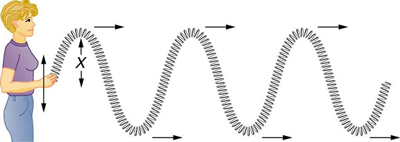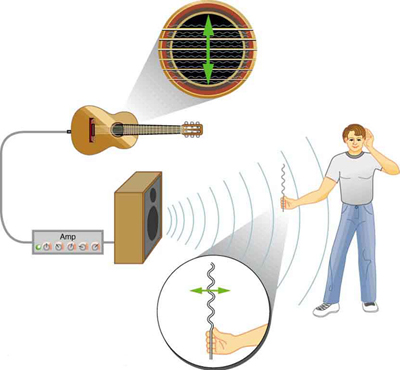| << Chapter < Page | Chapter >> Page > |


Waves may be transverse, longitudinal, or a combination of the two . (Water waves are actually a combination of transverse and longitudinal. The simplified water wave illustrated in [link] shows no longitudinal motion of the bird.) The waves on the strings of musical instruments are transverse—so are electromagnetic waves, such as visible light.
Sound waves in air and water are longitudinal. Their disturbances are periodic variations in pressure that are transmitted in fluids. Fluids do not have appreciable shear strength, and thus the sound waves in them must be longitudinal or compressional. Sound in solids can be both longitudinal and transverse.

Earthquake waves under Earth’s surface also have both longitudinal and transverse components (called compressional or P-waves and shear or S-waves, respectively). These components have important individual characteristics—they propagate at different speeds, for example. Earthquakes also have surface waves that are similar to surface waves on water.
The source of electricity is of a sinusoidal nature. If we appropriately probe using an oscilloscope (an instrument used to display and analyze electronic signals), we can precisely determine the frequency and wavelength of the waveform. Inquire about the maximum voltage current that you get in your house and plot a sinusoidal waveform representing the frequency, wavelength, and period for it.
Why is it important to differentiate between longitudinal and transverse waves?
In the different types of waves, energy can propagate in a different direction relative to the motion of the wave. This is important to understand how different types of waves affect the materials around them.
Watch a string vibrate in slow motion. Wiggle the end of the string and make waves, or adjust the frequency and amplitude of an oscillator. Adjust the damping and tension. The end can be fixed, loose, or open.

What is the difference between the waves coming from a tuning fork and electromagnetic waves?
The waves coming from a tuning fork are mechanical waves that are longitudinal in nature, whereas electromagnetic waves are transverse in nature.
Represent longitudinal and transverse waves in a graphical form.
Why is the sound produced by a tambourine different from that produced by drums?
The sound energy coming out of an instrument depends on its size. The sound waves produced are relative to the size of the musical instrument. A smaller instrument such as a tambourine will produce a high-pitched sound (higher frequency, shorter wavelength), whereas a larger instrument such as a drum will produce a deeper sound (lower frequency, longer wavelength).

Notification Switch
Would you like to follow the 'College physics for ap® courses' conversation and receive update notifications?